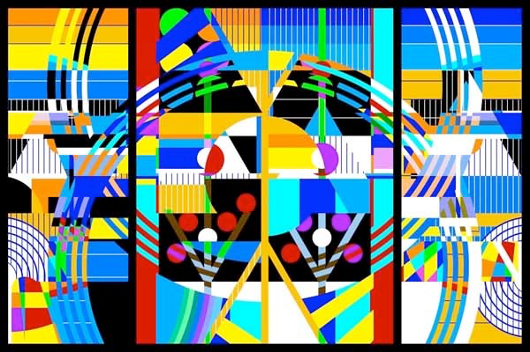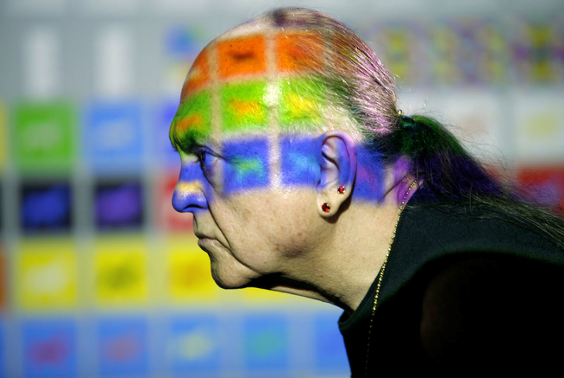Gary J. Coates
Department of Architecture; Kansas State University gcoates@ksu.edu
My images are about how Reality Is—and they are about how Reality appears, in the context of natural perception, as a construction made of primary shaping-forces. My image-art is, therefore, not merely “subjectively” or, otherwise, “objectively” based. Rather, the images I make and do always tacitly and utterly coincide with Reality As It Is. Therefore, I have called the process of the
Image-Art I make and do Transcendental Realism.”1
-Adi Da Samraj
Abstract
Over the course of nearly forty years artist, scholar and spiritual teacher Adi Da Samraj (19392008) produced a highly diverse, voluminous and unique body of artistic work, ranging from Zenlike ink brush paintings to multiple exposure photography, videographic suites synchronized with music and monumentally scaled abstract geometric images generated by digital technology.2 He also wrote extensively about his art and left behind hundreds of hours of recorded discourses about art in general and his own art in particular.3
Adi Da Samraj describes the “aperspectival, anegoic and aniconic” images he created with digital means between 2006 and 2008 as being the final resolution of his own lifelong work as a visual artist as well as being the fulfillment of the spiritual purpose that was only implicit in the art of such twentieth century abstract artists such as Kandinsky and Mondrian, i.e. complete liberation from the ego position, or what he called “point of view” itself. This presentation includes selections from all periods of his artistic production, with a focus on images from this last phase of his work.

Alberti’s Window I, 2006-2007 (from Geome One). Pigmented inks on paper and acrylic urethane paint on aluminum (54 inches x 559 inches). Part of solo exhibition at the 2007 Venice Biennale and the 2008 Winter in Florence exhibition.
Art, Consciousness and Culture
In 1435 architect and artist Leon Battista Alberti published his landmark book, Della Pittura (On Painting), which codified rules for the construction of linear geometric perspective, a technique of painting invented by architect Fillippo Brunelleschi some ten years earlier. As Adi Da points out, the invention of linear geometric perspective in the early Renaissance not only transformed the practice of painting, architecture and urban design, but it also “signaled a profound paradigm shift in European civilization—a shift from a culture centered on the ‘God’-idea to a culture centered on the human individual, or the ego.”4
In a complex and often paradoxical process following the invention of linear geometric perspective in Florence, the ego-centered and materialistic development of Western civilization progressed unchallenged for hundreds of years, following the inexorable logic of its own “point of view”-based premises and methods.5 Then, suddenly and unexpectedly at the beginning of the 20th century, all the arts and sciences exploded in what can only be described as a widespread rebellion in the western world against the limitations of perspectival thought, perception and expression.6 As a result, all prior understandings of the nature of space, time and reality in the domains of science, visual art, music and literature were forever changed, with consequences that are only now beginning to be realized.7
Expressing his appreciation for early modernist abstraction, Adi Da observed that “in the ‘modernist’ tradition of the early 20th century, a new, and, potentially, sacred, art emerged as a possibility—an art of profundity, free of both ‘official’ religion and merely secular impulses”.8 Yet, because of the process of civilizational collapse that was brought on by two World Wars and a global depression, Adi Da argued that the liberatory potential of this artistic revolution at the beginning of the twentieth century was never able to come to fruition. 9 Only now, at the beginning of the twenty-first century, did he believe that it was possible and, indeed, necessary for the “emergence of a new order of both civilization and culture—and, thus, for the emergence of a new, and truly sacred (non-religious, non-secular, and Really non-egoic), art.”10 Creating such an art was one of his own primary purposes. “My entire life has been spent in working to establish the basis for a “radically” new and “radically” comprehensive culture. My image-art is a summation, in artistic terms, of all the work I have done…Therefore, the images I make and do— like the books I have written—are intended to establish a new paradigm of human civilization.”11
It is only within the context of this historical circumstance and the framework provided by Adi Da’s own stated intentions that his image-art can be fully appreciated and understood.12

Center Panel (Wednesday) from Alberti’s Window I.
The Spiritual Purpose of Adi Da Samraj’s Image-Art
Adi Da Samraj’s intention in all of his artistic work was to create images which would enable the fully participatory viewer to experience at least a taste of the inherently blissful state of non-dual awareness which he asserts is our “Bright” native condition once we transcend the (false) presumption and (illusory) experience of being a separate “subjective self” perceiving a separate “objective reality.” To make such self-transcending, “aesthetic ecstasy” possible he formed each image to be what he called a “Self Presentation of ‘Reality Itself’,”13 which he describes as being inherently “Non-separate, One and Indivisible,”14 and always prior to space-time and every separate and separative “point of view.” As he said, “I am making art that is intended to be of greatest significance and transformative power—art that invites profound participation rather than the mode of casual and dissociated viewing….I want to transform people’s participation in art— and also their participation in Reality (Itself and altogether).”15
Thus, Adi Da did not think of his images as separate objects set over against a separate (and “subjective” ) self. Rather, he understood each image as a “performance-assisted subjective process”16 aimed at helping the viewer to tune into and become one with “Reality Itself, Truth Itself and Beauty Itself”, thereby restoring a sense of the always already existing unity and nondual wholeness of both “self” and “world”:
“The living body inherently wants to realize (or Be One With) the Matrix of life. The living body always wants (with wanting need) to allow the Light of Perfect Reality into the “room”. Assisting human beings to fulfill that impulse is what I would do by every act of image-art. My images are created to be a means for any and every perceiving, feeling, and fully participating viewer to “Locate” Fundamental and Really Perfect Light—the world As Light, conditional (or naturally perceived) light As Absolute Light.
Ultimately, when “point of view” is transcended there is no longer any “room” (or any separate “location” and separate “self” at all— but only Love-Bliss “Brightness”, limitlessly felt in vast unpatterned Joy.”17
This presentation offers an opportunity for conference participants to explore the relationships between art , architecture, consciousness and culture and to consider how the visual art of Adi Da Samraj might contribute to a rebirth of the sacred in our time.
Endnotes
- Adi Da Samraj, Transcendental Realism: The Art of Adi Da Samraj, (Middletown, CA: The Dawn
Horse Press), 2007, pg 27. (2007 Venice Biennale exhibition catalog with essays by Achille Bonito Oliva and exhibition Co-Curator Peter Frank as well as an artist’s statement by Adi Da Samraj).
- For an excellent overview of the visual art of Adi Da Samraj, see Mei-Ling Israel, The World as Light: An Introduction to the Art of Adi Da Samraj, (Middletown, CA: The Dawn Horse Press),
2007. Some of Adi Da’s early photographic works can be seen in Adi Da Samraj, The Bright Field: The Photographic Art of Adi Da Samraj, (Middletown, CA: The Dawn Horse Press), 2001. A selection of monumentally sized multiple-exposure images taken underwater can be seen in the exhibition catalogue, Adi Da Samraj, The Quandra Loka Suite: 52 Views (The Indivisible Space of Conscious Light), Louis Stern Fine Arts, 2003. This beautifully produced volume also includes an illuminating essay on Adi Da’s photographic art by noted critic Donald Kuspit. Adi Da’s large format book, The Spectra Suites, (New York and San Francisco: Welcome Press), 2007, presents works that integrate digitally generated images with those he has produced using still and video cameras. Donald Kuspit once again provides an incisive essay in this volume. See also Adi Da Samraj, Transcendental Realism: The Art of Adi Da Samraj, (2007 Vencice Biennale catalog), op. cit.. To learn more about Adi Da’s art also see: www.daplastique.com and www.adidabiennale.org.
3 Full-scale fabrications of Adi Da Samraj’s images have been made in a variety of media ranging from pigmented inks on canvas, to monumentally scaled paint on aluminum, sculptural light boxes, plasma screen installations, projected images as a context for theatrical performances and music-synchronized videographic presentations. In addition to receiving widespread critical acclaim from leading authors and art critics, his visual art has been exhibited in a number of prestigious national and international venues, including: a collateral exhibition at the 52nd Biennale di Venezia in 2007; an invited exhibition in Florence, Italy in 2008; a one man show at the LA Contemporary Gallery in 2008, and; an exhibition of a singular work at the Kemper Museum of Contemporary Art in Kansas City, Missouri, 2009-10. In 2009 The Florence Dance Company presented four highly acclaimed performances in Florence set to the music of Vivaldi’s Four
Seasons. Each production used four monumental images (one for each season) by Adi Da Samraj as the inspiration for costumes and choreography and as the backdrop for all performances. See the Venice Biennale exhibition catalog, Adi Da Samraj, Transcendental Realism: The Art of Adi Da Samraj, op. cit.. Adi Da’s essays on his art can be found in:
Transcendental Realism: The Image-Art of egoless Coincidence With Reality Itself, (Middletown, CA: The Dawn Horse Press), 2007; Aesthetic Ecstasy, (Middletown, CA: The Dawn Horse Press), 2007, and; Perfect Abstraction, (Middletown, CA; The Dawn Horse Press), 2008. 4 “Whereas, the “pre-Renaissance culture was, at root, about “surrendering the ego to the “God”idea”, the Renaissance culture “was, at root, about the idea of magnifying the knowledge and power of the ego, and about controlling and exploiting the world as constructed by the ego. Adi Da Samraj, Perfect Abstraction, op. cit., pg.15.
- For a carefully reasoned argument for the pivotal role perspective in the visual arts played in creating the basis for the scientific revolution in Western civilization see Samuel Y. Edgerton, Jr., The Heritage of Giotto’s Geometry: Art and Science on the Eve of the Scientific Revolution,
(Ithaca, NY: Cornell University Press), 1991 and Samuel Y. Edgerton, Jr., The Renaissance Rediscovery of Linear Perspective, (New York, NY; Basic Books, Inc.) 1975. The case for the role of perspective in the creation of the modern self and the modern world is strongly stated by Robert D. Romanyshyn in, Technology as Symptom and Dream, (London and New York; Routledge), 1989. See also, Margaret Wertheim, The Pearly Gates of Cyberspace: A History of Space from Dante to the Internet, (New York, NY; W. w. Norton and Co.), 1999.
- As he surveyed these and many other related changes in the western world of his time, Swiss philosopher and cultural historian Jean Gebser (1905-1973) had a sudden “lightning-like realization” in 1933 that what he was witnessing was the emergence of a radically new form of consciousness, which he called the aperspectival/integral consciousness structure. See Jean Gebser, The Ever-Present Origin, Athens, OH: Ohio University Press, 1949/1985. It is important to point out, however, that what Adi Da calls “aperspectival” consciousness and art is radically different from what Gebser means by the same terms. Fundamentally, Gebser is still communicating a “point-of-view”-based philosophy and psychology. By contrast Adi Da’s Transcendental Realist art is “anegoic”, and “aniconic” as well as “aperspectival”. Gebser is unable to distinguish between “multi-perspectival” art and truly “aperspectival” art in the sense communicated by Adi Da.
- For a fascinating and illuminating look at the relationship between science and art, and in particular, between post-Newtonian physics and modern art, see Leonard Shlain, Art & Physics: Parallel Visions in Space, Time & Light, New York, NY.: William Morrow, and Company, Inc., 1991.
- Adi Da Samraj, Transcendental Realism: The Image-Art of egoless Coincidence With Reality
Itself, op. cit., pg 72. In this same essay Adi Da further explains his view on the culture and art of “modernism”, which he regarded “to be the roots of a profoundly transformative and artistically librating renewal of the entire world-tradition of making and doing art. It is, therefore, necessary that the ‘liberating instant ‘of ‘modernism’ be continued, and always further developed, and even, in the best of case, exceeded…” pp 69-70.
- Adi Da Samraj, Transcendental Realism: The Image-Art of egoless Coincidence With Reality
Itself, op. cit., pg 69.
- Adi Da Samraj, Transcendental Realism: The Image-Art of egoless Coincidence With Reality
Itself, op. cit., pg 72.
- Adi Da Samraj, Perfect Abstraction, op. cit., pg 21. For an in-depth consideration of the crises of our times and the means by which to deal with them see, Adi Da Samraj, Not-Two Is Peace: The Ordinary People’s Way of Global Cooperative Order, (Middletown, CA: The Dawn Horse Press), 2008. (With an Introduction by Ervin Laszlo).
- For a more detailed explication of issues and themes in this paper see Gary J, Coates, The Rebirth of Sacred Art: Reflections on the Aperspectival Geometric Art of Adi Da Samraj, unpublished manuscript, 2008. Available, along with essays by leading art critics, at www.daplastique.com.
- Adi Da Samraj, Transcendental Realism: The Image-Art of egoless Coincidence With Reality
Itself, op. cit., pg 34.
- Adi Da Samraj, Perfect Philosophy: The “Radical” Way of No-Ideas, (Middletown, CA; The Dawn Horse Press) 2007, pg 40.
- Adi Da Samraj, Transcendental Realism: The Image-Art of egoless Coincidence With Reality
Itself, op. cit., pg 70.
- Mei-Ling Israel, op. cit., pg 18.
- Adi Da Samraj, Transcendental Realism: The Image-Art of egoless Coincidence With Reality
Itself, op. cit., pg 57.




